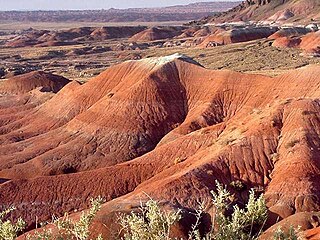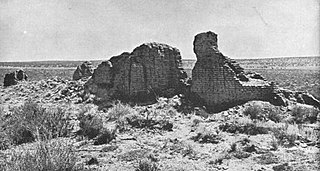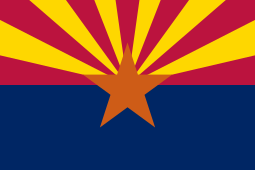Hernando de Alarcón was a Spanish explorer and navigator of the 16th century, noted for having led a 1540 expedition to the Colorado River Delta, during which he became one of the first Europeans to ascend the Colorado River from its mouth and became the first European to see Alta California.

Francisco Vázquez de Coronado was a Spanish conquistador and explorer who led a large expedition from what is now Mexico to present-day Kansas through parts of the southwestern United States between 1540 and 1542. Vázquez de Coronado had hoped to reach the Cities of Cíbola, often referred to now as the mythical Seven Cities of Gold. His expedition marked the first European sightings of the Grand Canyon and the Colorado River, among other landmarks. His name is often Anglicized as Vasquez de Coronado or just Coronado.

The Painted Desert is a United States desert of badlands in the Four Corners area, running from near the east end of Grand Canyon National Park and southeast into Petrified Forest National Park. It is most easily accessed from the north portion of Petrified Forest National Park. The Painted Desert is known for its brilliant and varied colors: these include the more common red rock, but also shades of lavender.

The national flag of the Philippines is a horizontal bicolor flag with equal bands of royal blue and crimson red, with a white, equilateral triangle at the hoist. In the center of the triangle is a golden-yellow sun with eight primary rays, each representing a province. At each vertex of the triangle is a five-pointed, golden-yellow star, each of which representing one of the country's three main island groups—Luzon, Visayas, and Mindanao. The white triangle at the hoist represents liberty, equality, and fraternity. A unique feature of this flag is its usage to indicate a state of war if it is displayed with the red side on top, which is effectively achieved by flipping the flag upside-down.

Gold, also called golden, is a color tone resembling the gold chemical element.

The official flag of New Mexico, a subnational polity of the United States, consists of a red sun symbol of the Zia people on a field of gold (yellow). It was officially adopted in 1925 to highlight the state's Native American and Hispano heritage: It combines a symbol of the Puebloan people, who have ancient roots in the state, with the colors of the flag of Spain, which established and ruled Nuevo México for over two and a half centuries.

In military organizations, the practice of carrying colours, standards, flags, or guidons, both to act as a rallying point for troops and to mark the location of the commander, is thought to have originated in Ancient Egypt some 5,000 years ago. The Roman Empire also made battle standards reading SPQR a part of their vast armies. It was formalized in the armies of Europe in the High Middle Ages, with standards being emblazoned with the commander's coat of arms.
Maroon is a brownish crimson color that takes its name from the French word marron, or chestnut. "Marron" is also one of the French translations for "brown".

The Blue Sky with a White Sun is the national emblem of the Republic of China (Taiwan).
Marcos de Niza, OFM was a Franciscan friar and missionary from the city of Nice in the Duchy of Savoy. Marcos led the first Spanish expedition to explore what is now the American Southwest. His report of finding a "beautiful city", "more extensive than that of Mexico [City]", induced Viceroy Antonio de Mendoza to organize a large-scale entrada under the leadership of Francisco Vázquez de Coronado. Marcos served as a guide for this expedition but when they failed to find the wealth they expected, Coronado blamed Marcos, called him a liar and sent the friar back to Mexico in disgrace.

Hawikuh, was one of the largest of the Zuni pueblos at the time of the Spanish entrada. It was founded around 1400 AD. It was the first pueblo to be visited and conquered by Spanish explorers. The Spanish chroniclers referred to it as Cevola, Tzibola, or Cibola.

Coronado High School in El Paso, Texas, United States is located on the west side of El Paso near the intersection of North Mesa Street and Resler Drive. It serves the southern part of west El Paso: east of Interstate 10, from the vicinity of Executive Center Boulevard north approximately three miles to around Coronado Arroyo, a normally dry stream bed running west down from the Franklin Mountains just north of Escondido Drive; and the portion of the Upper Valley which lies south of Country Club Road. Most of the Coronado attendance zone is zoned to Morehead Middle School for grades six to eight. The elementary schools in the Coronado feeder pattern include Dr. Green, L.B Johnson, Putnam, Carlos Rivera, Western Hills, and Zach White. The Upper Valley portion of the Coronado attendance area is zoned to Zach White Elementary and Lincoln Middle School, except for the Buena Vista neighborhood around Interstate 10 and West Paisano Drive, which is zoned to Johnson and Morehead. Dr. Green, L.B Johnson, Putnam, Carlos Rivera and Western Hills elementary schools all graduate into Morehead Middle School.

Coronado High School (CHS) is a public high school in Colorado Springs, Colorado, United States. It is part of the Colorado Springs School District 11.

Meers is an unincorporated community located on State Highway 115 in Comanche County, Oklahoma, United States, in the foothills of the Wichita Mountains. In 1901, Meers was founded as a gold prospecting town where it was named in honor of mine operator Andrew J. Meers from Cherokee County, Georgia.

The Zuni-Cibola Complex is a collection of prehistoric and historic archaeological sites on the Zuni Pueblo in western New Mexico. It comprises Hawikuh, Yellow House, Kechipbowa, and Great Kivas, all sites of long residence and important in the early Spanish colonial contact period. It was declared a National Historic Landmark District in 1974. These properties were considered as major elements of a national park, but the proposal was ultimately rejected by the Zuni people.

The myth of the Seven Cities of Gold, also known as the Seven Cities of Cíbola, was popular in the 16th century and later featured in several works of popular culture. According to legend, the seven cities of gold referred to Aztec mythology revolving around the Pueblos of the Spanish Nuevo México, today's New Mexico and Southwestern United States.
Juan de Zaldívar (1514–1570) was a Spanish official and explorer in New Spain. He served as a city councillor of Guadalajara from 1539 to 1570. He explored Northern New Spain in search of the mythical towns of Cíbola and Quivira. By the 1560s, he was the owner of mines, farms and slaves, and one of the richest men in New Spain.

The flag of Austin is the official municipal flag of Austin, Texas. The flag simply consists of a white field with the seal of Austin without the surrounding circle of text. Below the seal of Austin is the text "CITY OF AUSTIN", written in blue and arched upwards.
Pedro de Tovar was a Spanish explorer, military man and colonial administrator. He was part of Francisco Vazquez de Coronado's expedition and led the first expedition to Cibola in 1540. Tovar was also the first European to hear about the existence of the Grand Canyon, although he did not get to see it. He was also a member of Nuño Beltrán de Guzmán's troops during the conquest of Nueva Galicia, as well as collaborating in the colonization of Guadalajara and the foundation of Culiacán, in modern Mexico. After that, he was alcalde of Nueva Galicia and Culiacán.
















